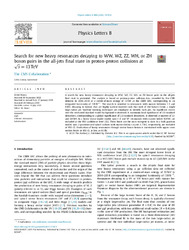Search for new heavy resonances decaying to WW, WZ, ZZ, WH, or ZH boson pairs in the all-jets final state in proton-proton collisions at s = √13 TeV
| dc.contributor.author | Tumasyan, A. | |
| dc.contributor.author | Işıldak, Bora | |
| dc.date.accessioned | 2023-11-09T11:38:13Z | |
| dc.date.available | 2023-11-09T11:38:13Z | |
| dc.date.issued | 2023-09-10 | |
| dc.identifier.issn | 0370-2693 | en_US |
| dc.identifier.uri | http://hdl.handle.net/10679/8969 | |
| dc.identifier.uri | https://www.sciencedirect.com/science/article/pii/S0370269323001478 | |
| dc.description.abstract | A search for new heavy resonances decaying to WW, WZ, ZZ, WH, or ZH boson pairs in the all-jets final state is presented. The analysis is based on proton-proton collision data recorded by the CMS detector in 2016–2018 at a centre-of-mass energy of 13 TeV at the CERN LHC, corresponding to an integrated luminosity of 138 fb−1. The search is sensitive to resonances with masses between 1.3 and 6TeV, decaying to bosons that are highly Lorentz-boosted such that each of the bosons forms a single large-radius jet. Machine learning techniques are employed to identify such jets. No significant excess over the estimated standard model background is observed. A maximum local significance of 3.6 standard deviations, corresponding to a global significance of 2.3 standard deviations, is observed at masses of 2.1 and 2.9 TeV. In a heavy vector triplet model, spin-1 Z′ and W′ resonances with masses below 4.8TeV are excluded at the 95% confidence level (CL). These limits are the most stringent to date. In a bulk graviton model, spin-2 gravitons and spin-0 radions with masses below 1.4 and 2.7TeV, respectively, are excluded at 95% CL. Production of heavy resonances through vector boson fusion is constrained with upper cross section limits at 95% CL as low as 0.1 fb. | en_US |
| dc.description.sponsorship | BMBWF and FWF (Austria); FRS- FNRS and FWO (Belgium); CNPq, CAPES, FAPERJ, FAPERGS, and FAPESP (Brazil); MES and BNSF (Bulgaria); CERN (Switzerland); CAS, MOST, and NSFC (China); MINCIENCIAS (Colombia); MSES and CSF (Croatia); RIF (Cyprus); SENESCYT (Ecuador); MoER, ERC IUT and ERDF (Estonia); Academy of Finland, MEC, and HIP (Finland); CEA and CNRS/IN2P3 (France); BMBF, DFG, and HGF (Germany); GSRI (Greece); NKFIH (Hungary); DAE and DST (India); IPM (Iran); SFI (Ireland); INFN (Italy); MSIP and NRF (Republic of Korea); MES (Latvia); LAS (Lithuania); MOE and UM (Malaysia); BUAP, CINVESTAV, CONACYT, LNS, SEP, and UASLP-FAI (Mexico); MOS (Montenegro); MBIE (New Zealand); PAEC (Pakistan); MES and NSC (Poland); FCT (Portugal); JINR, MON, RosAtom, RAS, RFBR, NRC KI (Russia); MESTD (Serbia); MCIN/AEI, FEDER (ERDF), and PCTI (Spain); MoSTR(Sri Lanka); ETH Board, ETH Zurich, PSI, SNF, UniZH, Canton Zurich, and SER (Switzerland); MST (Taipei); TCEP, IPTST, STFAR, and NSTDA (Thailand); TUBITAK and TENMAK (Turkey); NASU (Ukraine); STFC (United Kingdom); DOE and NSF (USA). | |
| dc.language.iso | eng | en_US |
| dc.publisher | Elsevier | en_US |
| dc.relation.ispartof | Physics Letters B | |
| dc.rights | Attribution 4.0 International | |
| dc.rights | openAccess | |
| dc.rights.uri | https://creativecommons.org/licenses/by/4.0/ | |
| dc.title | Search for new heavy resonances decaying to WW, WZ, ZZ, WH, or ZH boson pairs in the all-jets final state in proton-proton collisions at s = √13 TeV | en_US |
| dc.type | Article | en_US |
| dc.description.version | Publisher version | en_US |
| dc.peerreviewed | yes | en_US |
| dc.publicationstatus | Published | en_US |
| dc.contributor.department | Özyeğin University | |
| dc.contributor.authorID | (ORCID 0000-0002-0283-5234 & YÖK ID 124605) Işıldak, Bora | |
| dc.contributor.ozuauthor | Işıldak, Bora | |
| dc.creator | The CMS Collaboration | |
| dc.identifier.volume | 844 | en_US |
| dc.identifier.wos | WOS:001053536800001 | |
| dc.identifier.doi | 10.1016/j.physletb.2023.137813 | en_US |
| dc.subject.keywords | CMS | en_US |
| dc.subject.keywords | Diboson resonances | en_US |
| dc.subject.keywords | Substructure | en_US |
| dc.identifier.scopus | SCOPUS:2-s2.0-85167995430 | |
| dc.relation.publicationcategory | Article - International Refereed Journal - Institutional Academic Staff |
Files in this item
This item appears in the following Collection(s)
Share this page




